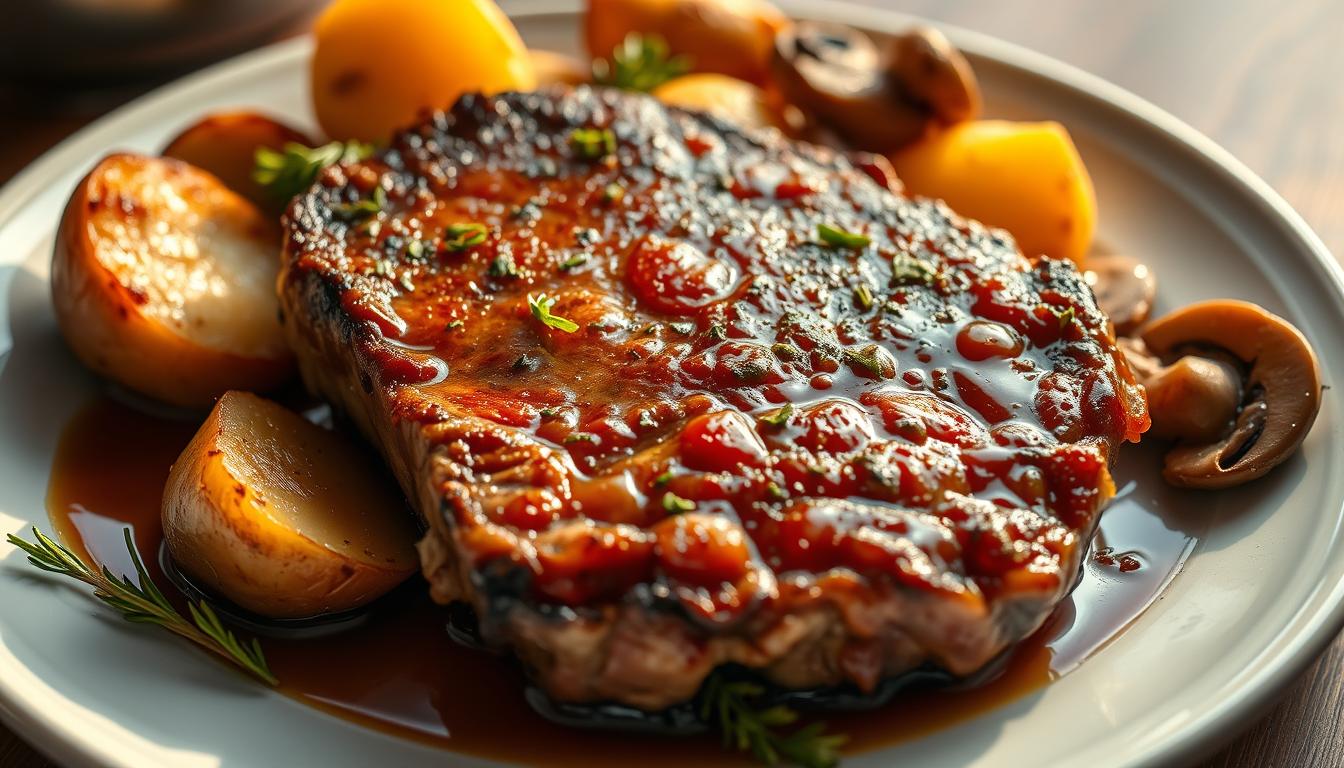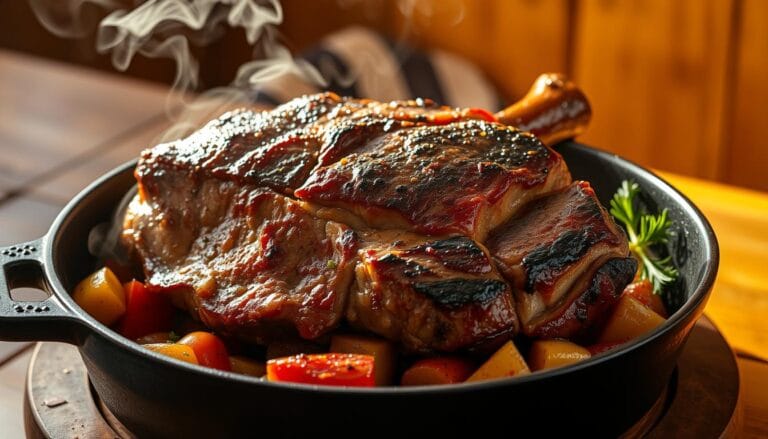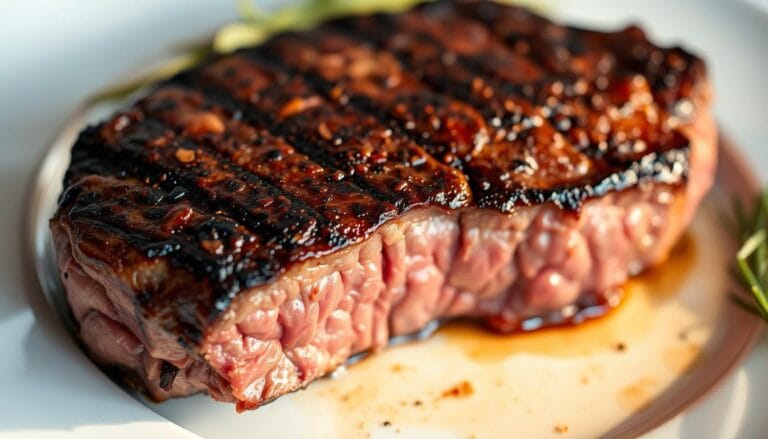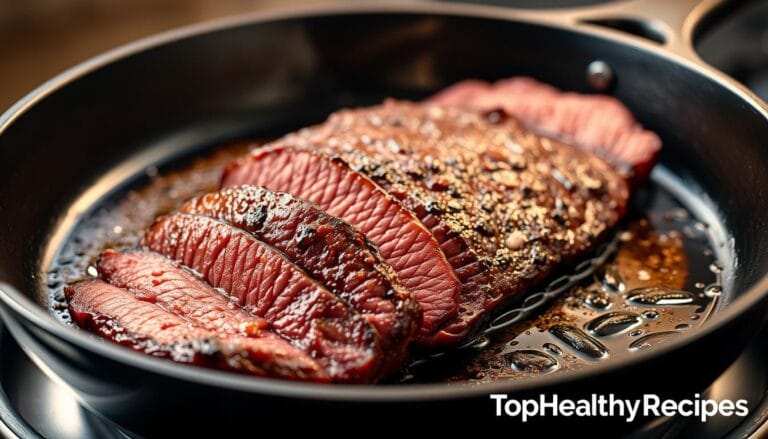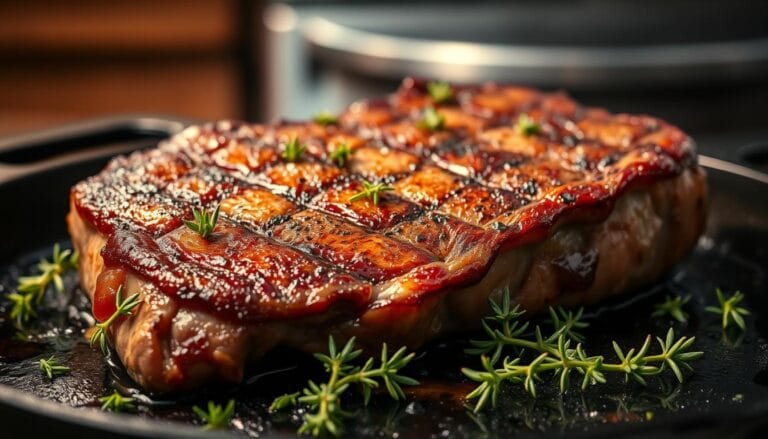How to Make the Delicious venison steak marinade at Home
How to Make a Delicious venison steak marinad at Home
Creating restaurant-quality wild game dishes in your own kitchen is easier than you think. With the right techniques, you can transform lean cuts into tender, flavorful meals that rival any high-end dining experience.
This simple recipe works beautifully with various wild game options. The secret lies in proper preparation and a well-balanced blend of seasonings that enhance natural flavors while softening the texture.
Whether you’re working with fresh harvest or frozen cuts, these methods will help you achieve perfect results every time. You’ll learn how to select the best ingredients, apply proper techniques, and cook to ideal doneness.
Key Takeaways
- Simple methods create tender, flavorful wild game dishes at home
- Proper preparation enhances texture and reduces gamey notes
- Works with various types of wild-harvested proteins
- Requires basic kitchen tools and common ingredients
- Techniques can be adapted for grilling or pan-searing
Introduction to Venison Steaks
Wild game has been a prized protein source for centuries, offering rich flavors and lean nutrition. Deer meat, in particular, stands out for its versatility in recipes ranging from rustic stews to elegant seared cuts.
Compared to beef, venison packs more protein with less fat. A 3-ounce serving delivers 26 grams of protein and just 3 grams of fat—ideal for health-conscious cooks. Here’s how it stacks up against common meats:
| Meat Type | Protein (g) | Fat (g) | Calories |
|---|---|---|---|
| Venison | 26 | 3 | 158 |
| Beef (90% lean) | 22 | 10 | 184 |
| Chicken Breast | 27 | 3 | 165 |
Cooking lean wild game requires care. Without enough fat, it can dry out quickly. Marinades help lock in moisture while tenderizing the fibers. A family recipe passed down through generations inspired the citrus-based blend in this guide.
Farmed and wild deer differ in taste and texture. Wild-harvested meat has a deeper, earthier flavor, while farm-raised options are milder. Both benefit from proper handling—always follow USDA guidelines for storing and preparing game to ensure safety.
This approach turns potential challenges into culinary triumphs. With the right techniques, even first-time cooks can achieve tender, flavorful results.
Gathering Your Ingredients
Quality components transform lean cuts into mouthwatering meals. Whether using a citrus-based blend or herbal infusion, each element serves a purpose. Below, we compare two popular marinade recipes and explain their roles.
Essential Marinade Components
Acids like lime juice tenderize fibers, while umami-rich soy sauce deepens flavor. Aromatics such as garlic and onion add complexity. Here’s how two versions stack up:
| Ingredient | Classic Blend | Herbal Alternative |
|---|---|---|
| Acid | 1/4 cup lime juice | 2 tbsp lemon juice |
| Umami | 2 tbsp soy sauce | 1 tbsp Worcestershire |
| Aromatics | 3 cloves garlic | 1 tsp smoked paprika |
| Oil | 1/3 cup canola | 1/4 cup olive oil |

Choosing the Best Cuts
Backstraps and ribeyes are ideal for their tenderness. For frozen meat, thaw it slowly in the fridge. Fresh cuts should be used within 3 days or vacuum-sealed for longer storage.
Oil selection matters too. Canola’s neutral taste won’t overpower, while olive oil adds richness. Always pat meat dry before cooking to ensure a perfect sear.
Preparing the Venison Steak Marinade
The right blend of ingredients can elevate wild game from tough to tender in just a few hours. A balanced soak enhances flavor while breaking down fibers for a melt-in-your-mouth texture.
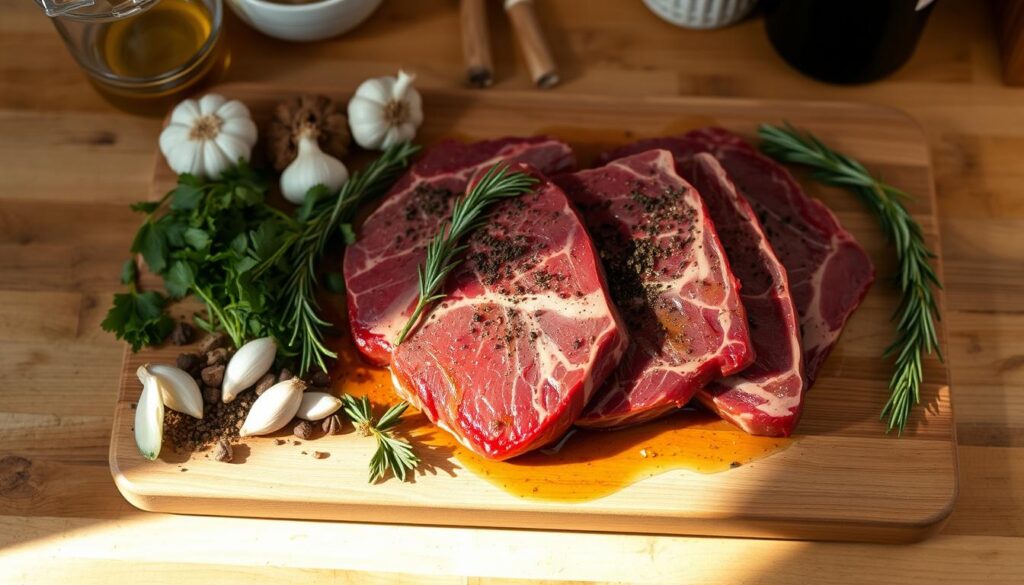
Mixing the Marinade
Whisk the liquid ingredients first—citrus juice and soy sauce—to emulsify the oils. Add minced garlic and spices last to preserve their aroma. For even distribution, pour the mixture into a zip-top bag with the meat.
Pro Tip: Soy sauce contains enzymes that naturally tenderize proteins. Combined with acid, it reduces cooking time while deepening umami notes.
Marinating Time and Techniques
A quick 1-hour soak works for thin cuts, but thicker pieces need 4–24 hours. Turn the bag occasionally to ensure full coverage.
- Refrigerate while marinating—never leave at room temperature.
- Pat meat dry before cooking to avoid steaming.
- Discard used marinade to prevent cross-contamination.
Wild game benefits most from this method, as it balances leanness with robust flavor. Adjust soak times based on cut thickness for consistent results.
Cooking Your Venison Steaks
Mastering the grill transforms lean cuts into juicy, flavorful meals with minimal effort. Follow these steps to achieve a perfect sear and tender interior every time.
Preheating the Grill
Start with a clean, oiled grill to prevent sticking. Heat to medium-high (400–450°F) for even cooking. Let the grates get hot—this ensures a crisp crust.
Grilling to Perfection
Sear each side for 5 minutes with the lid closed. Use tongs to flip—never pierce the meat. Watch for these doneness cues:
- Color: Pink centers fade to gray-brown
- Firmness: Springs back lightly when pressed
Remove at 145°F temperature (medium-rare). Rest 5 minutes; residual heat raises it to 150°F. For pan-searing, use a cast-iron skillet with the same timing.
Tip: If flare-ups occur, move cuts to cooler zones. Patting meat dry before grilling reduces drips.
Serving and Pairing Suggestions
Learn how to plate and pair your dish for maximum flavor and visual appeal. A well-balanced meal enhances the natural taste of wild game while adding nutritional value.
Plating Like a Pro
Slice meat against the grain for tenderness. Arrange it atop a bed of wild rice or roasted root vegetables for contrast. Drizzle with olive oil for a glossy finish.
Garnish with fresh herbs like rosemary or thyme. These add color and complement earthy flavors. Use warm plates to keep food at ideal temperature.
Nutritional Benefits
Each serving packs 169 calories and 23g of protein, making it a lean yet satisfying option. Here’s the full breakdown per 3-ounce portion:
| Nutrient | Amount |
|---|---|
| Calories | 169 |
| Protein | 23g |
| Fat | 7g |
| Iron | 15% DV |
Pair with a bold red wine like Syrah or a malty beer to balance richness. For leftovers, store in airtight containers for up to 3 days. Reheat gently to preserve moisture.
Tip: Repurpose extras into salads or grain bowls for quick recipes. The flavors deepen overnight, making next-day meals even better.
Conclusion
Turn your kitchen into a wild game haven with this adaptable recipe. It delivers tender results, bold flavors, and simplicity—perfect for home cooking adventures.
Feel free to tweak spices or herbs. The method works for venison, duck, or rabbit. Share your variations—we’d love to hear your twists!
Always handle raw game safely. Store properly and cook to recommended temperatures. Now, fire up the grill and enjoy your masterpiece.
FAQ
What’s the best cut for grilling?
Backstrap or tenderloin works best. These cuts stay tender and cook evenly on the grill.
How long should you soak the meat before cooking?
Aim for 4–12 hours. Longer soaking enhances flavor but avoid over-marinating to prevent mushiness.
Can you substitute soy sauce in the recipe?
Yes. Coconut aminos or Worcestershire sauce make great alternatives for a similar umami kick.
Should you trim fat before marinating?
Yes. Deer fat can taste gamey, so trim excess for a cleaner flavor.
What’s the ideal grill temperature?
Preheat to 400–450°F for a perfect sear without overcooking.
How do you know when it’s done?
Use a meat thermometer—130°F for medium-rare, 140°F for medium. Rest for 5 minutes before slicing.
What sides pair well with this dish?
Roasted veggies, garlic mashed potatoes, or a fresh arugula salad complement the rich flavors.
Can you freeze marinated cuts?
Absolutely. Freeze in an airtight bag for up to 3 months. Thaw in the fridge before cooking.
For more cooking tips, stay connected with us. We also recommend the cookbook Skinnytaste Simple: Easy, Healthy Recipes with 7 Ingredients or Fewer
For more Recipes about Steak ?
